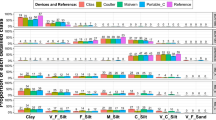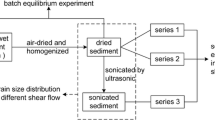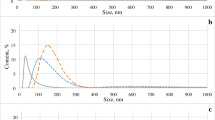Abstract
A method to separate sediments into discrete size fractions for geochemical analysis has been tested. The procedures were chosen to minimize the destruction or formation of aggregates and involved gentle sieving and settling of wet samples. Freeze-drying and sonication pretreatments, known to influence aggregates, were used for comparison. Freeze-drying was found to increase the silt/clay ratio by an average of 180 percent compared to analysis of a wet sample that had been wet sieved only. Sonication of a wet sample decreased the silt/clay ratio by 51 percent. The concentrations of metals and organic carbon in the separated fractions changed depending on the pretreatment procedures in a manner consistent with the hypothesis that aggregates consist of fine-grained organic- and metal-rich particles. The coarse silt fraction of a freeze-dried sample contained 20–44 percent higher concentrations of Zn, Cu, and organic carbon than the coarse silt fraction of the wet sample. Sonication resulted in concentrations of these analytes that were 18–33 percent lower in the coarse silt fraction than found in the wet sample. Sonication increased the concentration of lead in the clay fraction by an average of 40 percent compared to an unsonicated sample. Understanding the magnitude of change caused by different analysis protocols is an aid in designing future studies that seek to interpret the spatial distribution of contaminated sediments and their transport mechanisms.
Similar content being viewed by others
References
Ackermann F, Bergmann H and Schleichert U (1983) Monitoring of heavy metals in coastal and estuarine sediments — a question of grain-size: <20 µm versus <60 μm. Environ. Technol. Lett. 4:317–328
Adams D, Darby D and Young R (1980) Selected analytical techniques for characterizing the metal chemistry and geology of fine-grained sediments and interstitial waters. In: Baker RA (Ed), Contaminants and sediments, vol. 2. Ann Arbor, Michigan: Ann Arbor Science Publishers, pp 3–28
De Groot AJ and Allersma E (1975) Field observations on the transport of heavy metals in sediments. In: Krenkel PA (Ed), Heavy metals in the aquatic environment. Oxford: Pergamon Press, pp 85–101
De Groot AJ, Zschuppe KH and Salomons W (1982) Standardization methods of analysis for heavy metals in sediments. Hydrobiologia 92:689–695
Englemann EE, Jackson LL and Norton DR (1985) Determination of carbonate carbon in geological materials by coulometric titration. Chem. Geol. 53:125–128
Folk RL (1974) Petrology of sedimentary rocks. Austin, Texas: Humphill. 182 pp
Forstner U and Patcheenelam SR (1980) Chemical associations of heavy metals in polluted sediments from the lower Rhine Valley. Adv. Chem. Ser. 189(Part Water):177–193
Forstner U and Wittmann GTW (1983) Metal pollution in the aquatic environment. New York: Springer-Verlag, 486 pp
Forstner U, Ahlf W, Calmano W, Kersten M and Salomons W (1986) Mobility of heavy metals in dredged harbor sediments. In: Sly PG (Ed), Sediments and water interactions. The Hague: Dr. W. Junk B.V. Publ. pp 371–380
Hetherington JA and Jeffries DF (1974) The distribution of some fission product radionuclides in sea and estuarine sediments. Neth. J. Sea Res. 8:319–338
Horowitz AJ (1974) The geochemistry of sediments from the northern Reykjanes Ridge and the Iceland-Faroes Ridge. Mar. Geol. 17:103–122
Horowitz AJ and Elrich KA (1986) An evaluation of air elutriation for sediment particle size separation and subsequent chemical analysis. Environ. Technol. Lett. 7:17–26
Horowitz AJ and Elrich KA (1987) The relation of stream sediment surface area, grain size and composition to trace element chemistry. Appl. Geochem. 2:437–451
Jenne EA, Kennedy V, Burchard J and Ball J (1980) Sediment collection and processing for selective extraction and for total trace element analysis. In: Baker RA (Ed), Contaminants and sediments, vol 1. Ann Arbor, Michigan: Ann Arbor Science Publishers, pp 169–190
Mayer LM and Rossi PM (1982) Specific surface areas in coastal sediments: Relationships with other textural factors. Mar. Geol. 45:241–252
Poppe LJ, Fredericks JJ and Hathaway JC (1988) A computer program to calculate centrifugation parameters for sedimentation analyses. Comp. Geosci. 14:541–545
Rapin F, Tessier A, Campbell PG and Carignan R (1986) Potential artifacts in the determination of metal partitioning in sediments by a sequential extraction procedure. Environ. Sci. Technol. 20(8):836–840
Rendigs RR and Commeau JA (1987) Effects of disaggregation of fine-grained marine mud by two ultrasonic devices. J. Sediment. Petrol. 57:786–787
Salomons W and Forstner U (1984) Metals in the hydrocycle. Berlin: Springer-Verlag, 348 pp
Sholkovitz, ER (1990) Rare-earth elements in marine sediments and geochemical standards. Chem. Geol. 88:333–347
Singer JK, Anderson JB, Ledbetter MT, McCave IN, Jones KPN and Wright R (1988) An assessment of analytical techniques for the size analysis of fine-grained sediments. J. Sediment. Petrol. 58:534–543
Thomson E, Luoma S, Cain D and Johansson C (1980) The effect of sample storage on the extraction of Cu, Zn, Fe, Mn and organic material from oxidized estuarine sediments. Water Air Soil Pollut. 14:215–233
Thorne LT and Nickless G (1981) The relation between heavy metals and particle size fractions within the Severn estuary (U.K.) intertidal sediments. Sci. Total Environ. 19:207–213
Turekian KK and Wedepohl KH (1961) Distribution of the elements in some major units of the earth's crust. Bull. Geol. Soc. Am. 72:175–192
Wall GJ, Wilding LP and Smeck NE (1978) Physical, chemical and mineralogical properties of fluvial unconsolidated bottom sediments in northwestern Ohio. J. Environ. Qual. 7:319–325
Author information
Authors and Affiliations
Rights and permissions
About this article
Cite this article
Barbanti, A., Bothner, M.H. A procedure for partitioning bulk sediments into distinct grain-size fractions for geochemical analysis. Geo 21, 3–13 (1993). https://doi.org/10.1007/BF00775044
Received:
Revised:
Issue Date:
DOI: https://doi.org/10.1007/BF00775044




